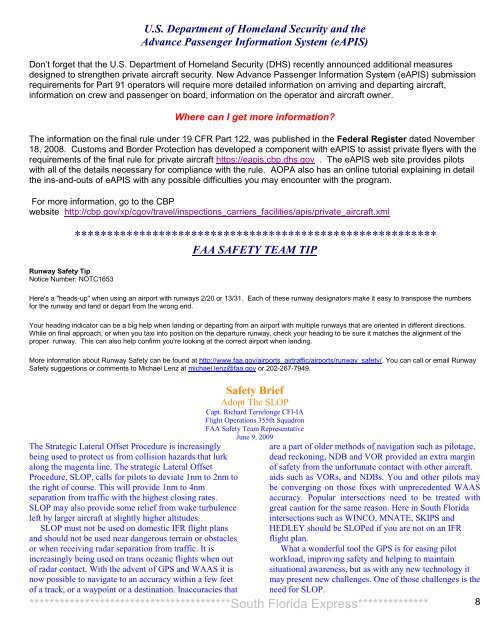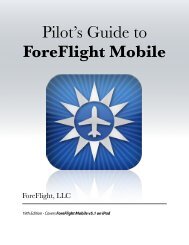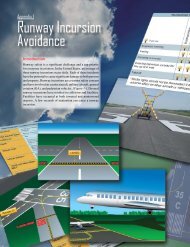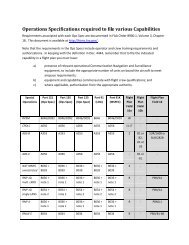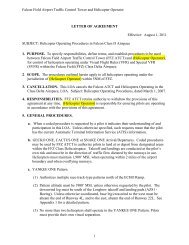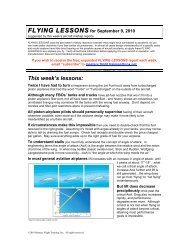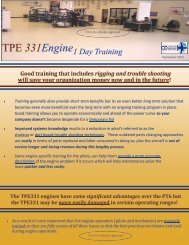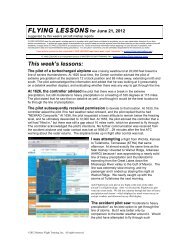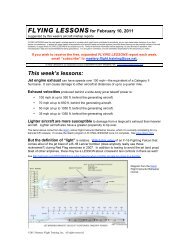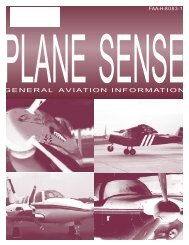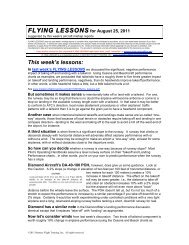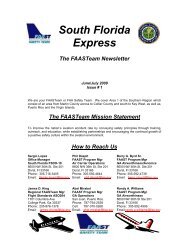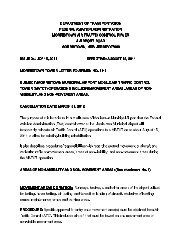South Florida Express The FAASTeam Newsletter - FAASafety.gov
South Florida Express The FAASTeam Newsletter - FAASafety.gov
South Florida Express The FAASTeam Newsletter - FAASafety.gov
You also want an ePaper? Increase the reach of your titles
YUMPU automatically turns print PDFs into web optimized ePapers that Google loves.
U.S. Department of Homeland Security and the<br />
Advance Passenger Information System (eAPIS)<br />
Don’t forget that the U.S. Department of Homeland Security (DHS) recently announced additional measures<br />
designed to strengthen private aircraft security. New Advance Passenger Information System (eAPIS) submission<br />
requirements for Part 91 operators will require more detailed information on arriving and departing aircraft,<br />
information on crew and passenger on board, information on the operator and aircraft owner.<br />
Where can I get more information?<br />
<strong>The</strong> information on the final rule under 19 CFR Part 122, was published in the Federal Register dated November<br />
18, 2008. Customs and Border Protection has developed a component with eAPIS to assist private flyers with the<br />
requirements of the final rule for private aircraft https://eapis.cbp.dhs.<strong>gov</strong> . <strong>The</strong> eAPIS web site provides pilots<br />
with all of the details necessary for compliance with the rule. AOPA also has an online tutorial explaining in detail<br />
the ins-and-outs of eAPIS with any possible difficulties you may encounter with the program.<br />
For more information, go to the CBP<br />
website http://cbp.<strong>gov</strong>/xp/c<strong>gov</strong>/travel/inspections_carriers_facilities/apis/private_aircraft.xml<br />
Runway Safety Tip<br />
Notice Number: NOTC1653<br />
********************************************************<br />
FAA SAFETY TEAM TIP<br />
Here's a "heads-up" when using an airport with runways 2/20 or 13/31. Each of these runway designators make it easy to transpose the numbers<br />
for the runway and land or depart from the wrong end.<br />
Your heading indicator can be a big help when landing or departing from an airport with multiple runways that are oriented in different directions.<br />
While on final approach, or when you taxi into position on the departure runway, check your heading to be sure it matches the alignment of the<br />
proper runway. This can also help confirm you're looking at the correct airport when landing.<br />
More information about Runway Safety can be found at http://www.faa.<strong>gov</strong>/airports_airtraffic/airports/runway_safety/. You can call or email Runway<br />
Safety suggestions or comments to Michael Lenz at michael.lenz@faa.<strong>gov</strong> or 202-267-7949.<br />
<strong>The</strong> Strategic Lateral Offset Procedure is increasingly<br />
being used to protect us from collision hazards that lurk<br />
along the magenta line. <strong>The</strong> strategic Lateral Offset<br />
Procedure, SLOP, calls for pilots to deviate 1nm to 2nm to<br />
the right of course. This will provide 1nm to 4nm<br />
separation from traffic with the highest closing rates.<br />
SLOP may also provide some relief from wake turbulence<br />
left by larger aircraft at slightly higher altitudes.<br />
SLOP must not be used on domestic IFR flight plans<br />
and should not be used near dangerous terrain or obstacles<br />
or when receiving radar separation from traffic. It is<br />
increasingly being used on trans oceanic flights when out<br />
of radar contact. With the advent of GPS and WAAS it is<br />
now possible to navigate to an accuracy within a few feet<br />
of a track, or a waypoint or a destination. Inaccuracies that<br />
Safety Brief<br />
Adopt <strong>The</strong> SLOP<br />
Capt. Richard Terrelonge CFI-IA<br />
Flight Operations 355th Squadron<br />
FAA Safety Team Representative<br />
June 9, 2009<br />
are a part of older methods of navigation such as pilotage,<br />
dead reckoning, NDB and VOR provided an extra margin<br />
of safety from the unfortunate contact with other aircraft.<br />
aids such as VORs, and NDBs. You and other pilots may<br />
be converging on those fixes with unprecedented WAAS<br />
accuracy. Popular intersections need to be treated with<br />
great caution for the same reason. Here in <strong>South</strong> <strong>Florida</strong><br />
intersections such as WINCO, MNATE, SKIPS and<br />
HEDLEY should be SLOPed if you are not on an IFR<br />
flight plan.<br />
What a wonderful tool the GPS is for easing pilot<br />
workload, improving safety and helping to maintain<br />
situational awareness, but as with any new technology it<br />
may present new challenges. One of those challenges is the<br />
need for SLOP.<br />
8<br />
****************************************<strong>South</strong> <strong>Florida</strong> <strong>Express</strong>**************


